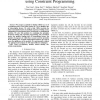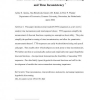ICDE
2009
IEEE
13 years 2 months ago
2009
IEEE
There is a huge wealth of sequence data available, for example, customer purchase histories, program execution traces, DNA, and protein sequences. Analyzing this wealth of data to ...
SIGDIAL
2010
13 years 2 months ago
2010
This paper proposes a novel approach for predicting user satisfaction transitions during a dialogue only from the ratings given to entire dialogues, with the aim of reducing the c...
ICPR
2010
IEEE
13 years 2 months ago
2010
IEEE
In this paper, we propose a novel approach to capture the dynamic deformation caused by facial expressions. The proposed method is concentrated on the spatiotemporal plane which i...
BIBM
2010
IEEE
13 years 2 months ago
2010
IEEE
We propose a method for finding CRMs in a set of co-regulated genes. Each CRM consists of a set of binding sites of transcription factors. We wish to find CRMs involving the same t...
ACL
2010
13 years 2 months ago
2010
Classical Information Extraction (IE) systems fill slots in domain-specific frames. This paper reports on SEQ, a novel open IE system that leverages a domainindependent frame to e...
WABI
2010
Springer
13 years 2 months ago
2010
Springer
Quantification of selective pressures on regulatory sequences is a central question in studying the evolution of gene regulatory networks. Previous methods focus primarily on sing...
TCOM
2010
13 years 2 months ago
2010
—Training sequences for data-aided timing estimation in multi-input multi-output systems are designed. It is observed that for low complexity implementation, the sequences must n...
RAID
2010
Springer
13 years 3 months ago
2010
Springer
Abstract. Run-time malware detection strategies are efficient and robust, which get more and more attention. In this paper, we use I/O Request Package (IRP) sequences for malware d...
MANSCI
2010
13 years 3 months ago
2010
This paper introduces time-tradeoff (TTO) sequences as a new tool to analyze time inconsistency and intertemporal choice. TTO sequences simplify the measurement of discount functio...
INFORMATICALT
2010
13 years 3 months ago
2010
The genetic information in cells is stored in DNA sequences, represented by a string of four letters, each corresponding to a definite type of nucleotides. Genomic DNA sequences a...


